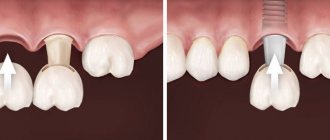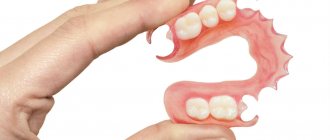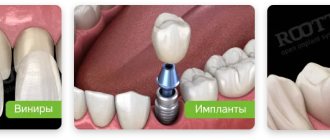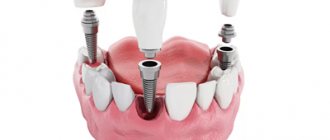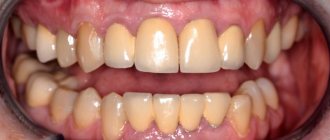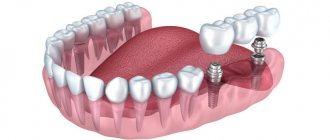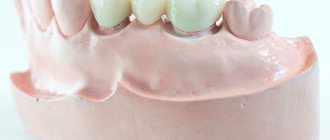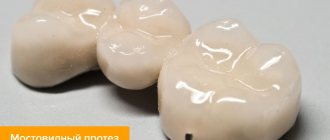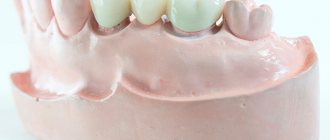A bridge is a fused orthopedic structure used to replace one or more missing teeth in a row, usually one to three. Before the advent of implantation, bridges were used everywhere. In terms of their advantageous characteristics, classical bridges are unlikely to be able to compete on equal terms with implantation. However, each technique has its own disadvantages and contraindications, so the choice is made after analyzing a number of factors.
Pros of installing an implant
During implantation, the artificial root serves as a support for the crown. Most often, high-strength titanium is used, which ensures complete inertness. This eliminates the risk of rejection and allergic reactions. Implants fully perform the functions of teeth: they restore chewing efficiency, are responsible for uniform load on the jaw bone, and maintain the shape of the gums. The appearance of an artificial neighbor does not affect the units located nearby, since titanium structures are implanted into the jaw bone, after which a crown or bridge is installed on them.
- reliability, strength, durability of structures;
- over time, bone tissue does not atrophy;
- no need to remove pulp from adjacent units;
- With proper care they can last a lifetime.
- relatively high cost;
- the presence of contraindications (diseases of the circulatory system, oncology, HIV, decompensated diabetes mellitus, diseases of the immune and endocrine systems, scleroderma, lupus erythematosus, etc.);
Implantation.
Implants are a much more advanced, technologically and practically complex technique, but this is the only option at the moment for replacing missing teeth, which returns patients the opportunity to fully chew, smile, and live a normal life without affecting the neighboring teeth next to the removed one.
The main disadvantages are:
- The cost is higher
(but this is not always the case - for example, the return of one missing tooth using the implantation technique comes out to approximately the same cost as the manufacture of a bridge with the preparation of teeth for prosthetics under standard conditions in terms of bone tissue volume). - The timing of return is a controversial point
. Nowadays they often use one-stage loading under good conditions - this is when, when placing an implant, a temporary crown is immediately made and it turns out that this option is the fastest, since making a bridge requires 1.5-2 weeks plus therapeutic treatment of the supporting teeth 2-4 visits, and this is still a week. And it turns out that by following the implantation method, the patient can get results almost immediately, but with bridge structures, 3 weeks and many visits (2-4 visits to the therapist, 3 to the orthopedist, 1 to the periodontist) there is a very large loss of time, which is very valuable for any person. - Fear of any surgical procedures
. Today, this is a solvable problem, given the presence of an anesthesiology department and the possibility of using sedation in the clinic, patients tolerate all manipulations calmly, comfortably and without fear.
The use of implants provides the patient with a number of advantages:
- There is no need to involve neighboring teeth
, i.e. there is no need to grind or depulp adjacent teeth. - Possibility of fairly quick prosthetics
: in some cases, an implant can be installed immediately after tooth extraction or after a short period of time, which shortens the standard work protocol by an average of 2-6 months. - The load on the bone that the implant transfers is comparable to natural
. Practice shows that if implantation is not delayed and the implant is placed immediately after removal, then bone atrophy will be only 2-3 percent. Thanks to this, it is possible to preserve the volume of bone ridge and gum necessary for aesthetics in order to recreate a beautiful smile. - The ability to use implants for a long time
(there is no service life and lifelong use is possible) due to the fact that the implant is made of titanium, which has high strength, wear resistance and hypoallergenicity. - Excellent integration
(survival) rates of implants (96-98%) due to the use of hypoallergenic materials. - The ability to use implants for removable prosthetics
when fixing removable and conditionally removable structures.
So the choice is yours and you need to take into account all the points and your wishes.
Pros and cons of classic bridges
- Not bad functionality.
- Fewer contraindications compared to implantation.
- In terms of cost, this is a more budget-friendly restoration option.
- The need for turning. The procedure usually requires depulpation of healthy supporting teeth.
- Lack of load provokes bone tissue atrophy.
- Mediocre aesthetics.
Bridge or implant on the front tooth?
When restoring teeth in the smile area, implantation is recommended. If several teeth are missing at once, it is better to replace them separately (one tooth - one implant). However, an option with a bridge prosthesis is also possible, but with support on artificial roots, and not on the patient’s own teeth. A combination of two techniques (implantation and bridge installation) is used in cases of the absence of several teeth in a row or their complete loss. In this case, the number of supporting implants depends on the duration of the bridge structure. This method of restoration eliminates the grinding of healthy teeth and ensures a reliable connection of the prosthesis to the jaw. Dentures on implants last longer than bridges installed on natural teeth.
Classic bridges on the front teeth are also one of the solutions, especially in the case of absolute contraindications to implantation or with limited financial resources. Modern bridges can be made of solid ceramics or zirconium: for front teeth this will be the best option, but it will be more expensive than conventional metal-ceramics.
Dental bridges in dentistry
A bridge prosthesis or bridge is a one-piece structure that makes it possible to restore individual previously removed or fallen out teeth. It is fixed on two adjacent pre-turned support units.
Advantages and disadvantages
Each type of treatment has its positive and negative sides. Advantages of dentures with bridges :
- speed of installation;
- aesthetically the bridge looks very natural;
- the design does not contain metal;
- no contact with gums;
- the procedure is not traumatic;
- reliable fixation;
Flaws:
- grinding of adjacent units is required;
- unskilled work by a doctor can lead to damage to healthy teeth under the prosthesis;
- short service life;
- when the bridge is chosen incorrectly, periodontal overload may occur;
- sometimes there is a feeling of discomfort when wearing;
- the development of bone atrophy cannot be excluded.
Even with good care, bridge systems will not last long. Plus, during use they change color, wear out, and sometimes cause allergic reactions.
What complications can there be?
Immediately after installing the bridge, a person experiences unpleasant sensations. This is due to the adaptation of the receptors of the tongue and cheeks. Three days later the situation returns to normal. In case of prolonged discomfort, polishing by a specialist may be required. It should not be neglected, otherwise, due to irrational load, the structure may crack , or the supporting teeth will begin to hurt.
During operation of the bridge, food may become clogged under it. This cannot be avoided. Space is deliberately left between the gum and the denture, otherwise there is a risk of bedsores. The problem can be solved by using a toothbrush, irrigator, or floss.
It happens that the bridge comes unstuck. If this happens almost immediately after installation, the cause is most likely due to accidental ingestion of saliva during fixation. There is no need to delay visiting the dentist. This threatens to displace the structure . An allergic reaction may occur . The phenomenon is uncommon, but occurs periodically.
The result of rejection of the bridge structure can be intoxication of the body. Such cases must be urgently addressed in a clinical setting.
What to choose for chewing teeth?
In the case of chewing teeth, functionality comes to the fore. A dental implant can withstand chewing loads one hundred percent. In the case of a classic bridge, all the “work” falls on the natural teeth on which the prosthesis is attached. Experiencing additional stress, over time, the supporting teeth are destroyed and deformed.
Dental bridge or implant - which is better from an economic point of view?
The question of what to install (a bridge or an implant) in the event of the loss of one or more teeth is also relevant from a financial point of view. If you are on a limited budget and cannot afford to restore your teeth with implants, choose bridge structures. But keep in mind that classic bridges have a limited service life and need to be replaced over time. In the long term, implantation is a more profitable option for restoring teeth, despite the fact that implant-supported dentures are the most expensive. For example, one budget category implant and metal-ceramic crown will cost approximately 35,000 rubles: premium implants and prostheses can double this amount.
Classic bridges are cheaper: the price for a bridge of three crowns starts from 30,000 rubles. Designs made of ceramics and zirconium dioxide will cost more. For example, a ceramic bridge made using E-max technology costs from 60,000 rubles. Agree, this amount does not fit into the budget solution. In addition, the price of installing a classic bridge does not include the cost of preparing supporting teeth, while depulpation of one molar can cost more than 5,000 rubles. Add to this amount further expenses for replacing the prosthesis. As a result, the cost of a conventional bridge will be comparable to the cost of implantation.
How to remove
Cases when dismantling is required:
- The support was not sufficiently prepared. The doctor performed the filling poorly, resulting in a risk of an inflammatory process.
- The cement composition has collapsed. The restoration procedure is impossible without removing the structure.
- The service life has expired. Old elements are dismantled, and new ones are fixed in their place.
- The crown was produced with a defect. It may not fit tightly and, as a result, injure the mucous membranes in the oral cavity and affect the bite.
- Some parts began to loosen and fall out.
Procedure for the dentist:
- Sawing. The crown is removed using a special tool that prys up the edges. If this is not possible, you need to cut the material. It will not be possible to maintain the integrity of the installation.
- Removal using the Koch apparatus. Under the influence of ultrasonic waves, the cement is destroyed, then the device itself is applied directly. The artificial element is loosened by shocks, but the natural incisors, canines and molars, along with the cavities, remain intact.
Is it painful to remove a dental bridge?
The procedure usually does not cause pain. Painful sensations occur when there is a living unit under the crown in which the inflammatory process has begun. But this rarely happens, because usually bridge structures are installed after pulp removal, that is, pain should be completely absent. If necessary, the doctor will apply anesthesia.
If the product is removed and discomfort persists, this may indicate injury to the mucous membranes or the development of pulpitis or periodontitis. In such a situation, endodontic therapy is indicated.
